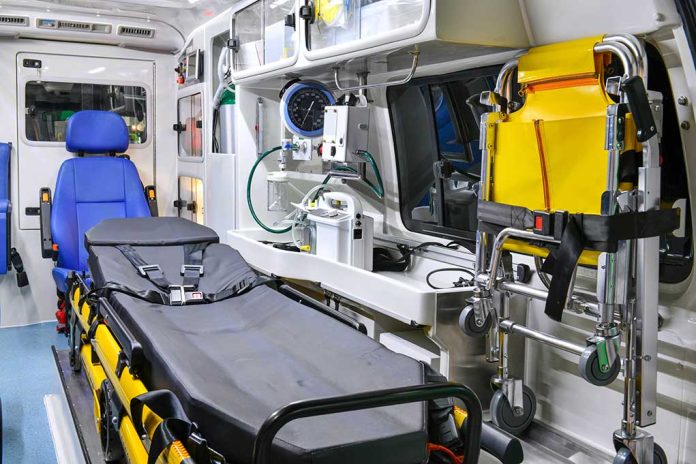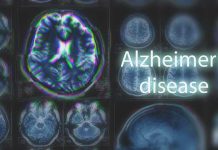
When a stroke strikes, every minute without emergency treatment costs nearly 2 million brain cells, yet more than a third of Americans still don’t know all the warning signs or why calling 911 is crucial to survival.
At a Glance
- Stroke is the fifth leading cause of death in the U.S., with approximately 800,000 Americans suffering a stroke annually, but up to 80% of strokes may be preventable.
- From 2009 to 2014, public awareness of stroke symptoms significantly improved by 14.7 percentage points, exceeding national health goals.
- When experiencing stroke symptoms, calling 911 results in faster treatment than self-transport, as paramedics can begin lifesaving care immediately and alert hospitals in advance.
- The F.A.S.T. acronym (Face drooping, Arm weakness, Speech difficulties, Time to call 911) is most effective for helping people remember key stroke warning signs.
- On average, 1.9 million brain cells die every minute a stroke goes untreated, making immediate recognition and emergency response critical.
Understanding Stroke Symptoms and Risk
Strokes occur when blood flow to part of the brain is interrupted, either by blockage (ischemic stroke) or bleeding (hemorrhagic stroke). Without oxygen, brain cells begin to die rapidly, leading to potentially permanent disability or death. According to national health statistics, stroke remains the fifth leading cause of death in the United States and a major cause of long-term disability. Approximately 800,000 Americans suffer a stroke each year, with women facing higher risks than men. “Women have a higher risk of stroke, with 1 in 5 women aged 55-75 experiencing a stroke,” notes Monica Emde from BJC Healthcare.
Despite these alarming statistics, awareness of stroke symptoms has improved significantly over the past decade. A comprehensive study using data from the National Health Interview Survey found that from 2009 to 2014, Americans’ awareness of stroke symptoms increased by 14.7 percentage points, surpassing the goals set by the Healthy People 2020 initiative.
Recognizing the warning signs of stroke quickly can make the difference between recovery and lifelong disability. The most common symptoms include sudden numbness or weakness in the face, arm, or leg (especially on one side); sudden confusion or trouble speaking; sudden vision problems; sudden trouble walking, dizziness, or loss of balance; and sudden severe headache with no known cause. In 2014, awareness of these symptoms ranged from 76.1% for sudden severe headache to 93.7% for numbness of face, arm, leg, or side. However, some symptoms are often overlooked, particularly in women.
“When you think of stroke, a drooping face, inability to speak and weakness on one side are usually what most people associate as signs or symptoms of the disease,” explains Monica Emde from BJC Healthcare. “But generalized weakness, or someone complaining of being extremely fatigued or lethargic, can also be symptoms of stroke that go unnoticed or are attributed to something else.”
Knowing FAST can save a life. If you notice any of these signs of a stroke, immediately dial 911. Take this complimentary health education lesson to understand how to lower your chances of having a stroke. https://t.co/2WplPhWm6d pic.twitter.com/7qT0ixJgZW
— American Heart Association (@American_Heart) June 20, 2024
The Critical Importance of Calling 911
When it comes to stroke response, the decision to call 911 rather than driving to the hospital can be lifesaving. Emergency medical services provide immediate care the moment they arrive, begin critical assessments, administer preliminary treatments, and alert the hospital so specialized stroke teams can prepare.
“The sooner someone calls 911, the faster the process can start,” emphasizes Monica Emde from BJC Healthcare. This head start in treatment is crucial because brain cells die rapidly during a stroke. The American Stroke Association estimates that 1.9 million brain cells die every minute a stroke goes untreated, highlighting why immediate emergency response is essential. Paramedics can also determine which hospital is best equipped to handle the specific type of stroke, routing patients to specialized stroke centers when appropriate, rather than the nearest general hospital.
“It is critically important that there is a recognition of stroke signs and symptoms by the general public. The more people are aware of the stroke warning signs, the better we may activate the processes needed to ensure patients get care as quickly as possible.” – Opeolu Adeoye, M.D., M.S., FAHA American Heart Association
Despite the clear benefits of calling 911, many people hesitate to make the call, often due to uncertainty about symptoms, denial, or concerns about cost. Some individuals attempt to drive themselves to the hospital, which can be dangerous as stroke symptoms may impair driving ability. Others rely on family members who lack the training to handle complications during transport.
Financial concerns should never prevent someone from calling emergency services. Federal laws ensure that emergency departments must provide treatment regardless of the patient’s ability to pay, and the Affordable Care Act requires most health insurance plans to cover emergency services. As health professionals consistently advise, when in doubt about symptoms, it’s always better to call 911 than risk the devastating consequences of delayed stroke treatment.
Stroke is an emergency and every minute counts! Call 911 if you notice:
• Face dropping
• Numbness or weakness in limbs
• Difficulty speaking and confusion
• Sudden trouble seeing
• Sudden severe headache
• Dizziness and trouble walking
• Nauseahttps://t.co/hC88fXypxG— Veterans Health (@VeteransHealth) February 20, 2025
Types of Strokes and Their Warning Signs
There are three main types of strokes, each with potentially different manifestations but requiring equally urgent medical attention. Ischemic strokes, which account for about 87% of all strokes, occur when a blood clot blocks a blood vessel in the brain. Hemorrhagic strokes happen when a blood vessel in the brain ruptures, causing bleeding into or around brain tissue. Transient Ischemic Attacks (TIAs), often called “mini-strokes,” produce stroke-like symptoms that typically resolve within minutes to hours but serve as serious warning signs for future strokes. There are also silent strokes, which occur without noticeable symptoms but can be detected through brain imaging and may increase the risk of dementia. Understanding these different types helps explain why symptoms can vary and why all suspected strokes require immediate emergency care.
“Experiencing face drooping—a stroke symptom—his ischemic stroke came “out of the blue.”” – Manuel Vera American Stroke Association
To help people identify stroke symptoms quickly, several acronyms have been developed. The most widely recognized is F.A.S.T., which stands for Face drooping, Arm weakness, Speech difficulties, and Time to call 911. An expanded version, BE-FAST, adds Balance and Eyes (vision problems) to the list. Research has shown that both acronyms effectively motivated people to call 911 when encountering possible stroke symptoms, with the impact lasting for at least 30 days after exposure to the messaging.
However, the simpler F.A.S.T. acronym proved more effective at helping people remember the key warning signs. “Historically, health care professionals want to provide the most comprehensive warning sign mnemonic to ensure no strokes are missed. What this research shows is, from a public point of view, adding two extra letters made it more challenging to recall the stroke warning signs,” explains Opeolu Adeoye, M.D., M.S., FAHA from the American Heart Association.
For #WorldStrokeDay, learn the BE FAST acronym that will help you identify #stroke. If you or a family member experience any of the following symptoms, call 911 immediately.
Learn more at https://t.co/uSRBDeos3k pic.twitter.com/bQgJ4MSPbU
— UCI Health (@UCIrvineHealth) October 29, 2024
Time-Critical Treatment and Outcomes
The phrase “time is brain” is fundamental to stroke care, emphasizing the urgency of treatment. When a stroke occurs, approximately 1.9 million brain cells die every minute without treatment, which can lead to permanent damage. Modern stroke treatments are remarkably effective when administered promptly. For ischemic strokes, clot-busting medications like tissue plasminogen activator (tPA) can dissolve the blockage, but they must be given within 3-4.5 hours of symptom onset to be effective. More advanced treatments, such as mechanical thrombectomy, where doctors physically remove the clot, have slightly longer windows but still require rapid intervention. The sooner treatment begins, the better the chances of minimizing or even reversing brain damage. “The faster you call 911 and get to the hospital, the more likely you are to have a successful and full recovery,” states Alex Davis from BJC Healthcare.
Early medical intervention through the emergency system provides the best chance of stopping and reversing brain damage. When emergency responders arrive, they immediately begin assessment and care, often administering tests and treatments that would otherwise be delayed if the patient arrived at the hospital by private transportation. Paramedics can also alert the hospital in advance, allowing stroke teams to prepare and mobilize specialized resources before the patient arrives. Some areas have implemented mobile stroke units—ambulances equipped with CT scanners and stroke specialists—that can begin diagnosis and treatment even before reaching the hospital. These advances in emergency stroke care have significantly improved outcomes, but they depend entirely on the patient or bystanders recognizing the symptoms and immediately calling 911.
“Stroke is a leading cause of disability and death, but it doesn’t have to be.” – Joshua Marcus, MD Nuvance Health
While stroke remains a leading cause of death and disability, the outlook for patients has improved dramatically with advances in treatment and increases in public awareness. Studies show that up to 80% of strokes may be preventable through lifestyle changes such as regular exercise, healthy eating habits, blood pressure management, and avoiding tobacco.
This prevention, combined with faster emergency response times and improved treatment options, has contributed to declining stroke mortality rates in the United States. However, the benefits of these medical advances can only be realized if patients receive care quickly. “Listen, a stroke is no joke,” warns Dr. Joshua Marcus from Nuvance Health. For those who do experience a stroke, recovery can be a long process involving physical therapy, occupational therapy, speech therapy, and other rehabilitation services, with outcomes largely dependent on how quickly treatment was initiated.
Prevention and Public Health Education
Preventing strokes begins with understanding and managing risk factors. High blood pressure, often called the “silent killer,” is the single most significant risk factor for stroke. Other major risk factors include smoking, diabetes, high cholesterol, physical inactivity, obesity, and atrial fibrillation. Some risk factors, such as age, gender, race, and family history, cannot be modified, but awareness of these factors can help individuals and healthcare providers remain vigilant.
Regular check-ups, medication adherence for conditions like hypertension, and lifestyle modifications are essential preventive measures. Public health campaigns have played a crucial role in increasing awareness about stroke prevention and recognition. These efforts, combined with improved medical treatments, have contributed to a 40% decrease in stroke death rates since the late 1990s.
Educational initiatives about stroke symptoms and the importance of calling 911 have shown measurable success. The National Health Interview Survey data revealed significant improvements in stroke awareness between 2009 and 2014, with the percentage of adults who could identify all symptoms and knew to call 911 increasing from 39% to 53.8%. These improvements spanned across demographic groups, although disparities persist based on factors like education level, race, and ethnicity. Public health organizations continue to work on closing these gaps through targeted education and outreach.
Additional resources for stroke education and support are available through organizations like the American Stroke Association, which offers a Stroke Family Warmline for those seeking information or support following a stroke. With continued education and prompt recognition of stroke symptoms, followed by immediate calls to emergency services, more lives can be saved and more patients can achieve better recovery outcomes.
“This research was unique in that it blends health care terminology, methods and randomized approaches to identify how we can most effectively deliver messages to the public in a way that will allow us to reduce the burden of stroke.” – Opeolu Adeoye, M.D., M.S., FAHA American Heart Association
The journey toward reducing stroke’s impact on public health combines prevention, recognition, and rapid response. While medical advances continue to improve treatment options, the most critical factor remains the public’s ability to recognize stroke symptoms and act quickly by calling 911. Through ongoing education and awareness campaigns, health authorities aim to ensure that everyone knows the signs of stroke and understands that immediate emergency response provides the best chance for recovery. Remember F.A.S.T. – Face drooping, Arm weakness, Speech difficulties, Time to call 911 – because when it comes to stroke, every minute counts, and calling 911 immediately can make all the difference between life, death, and quality of life after stroke.






